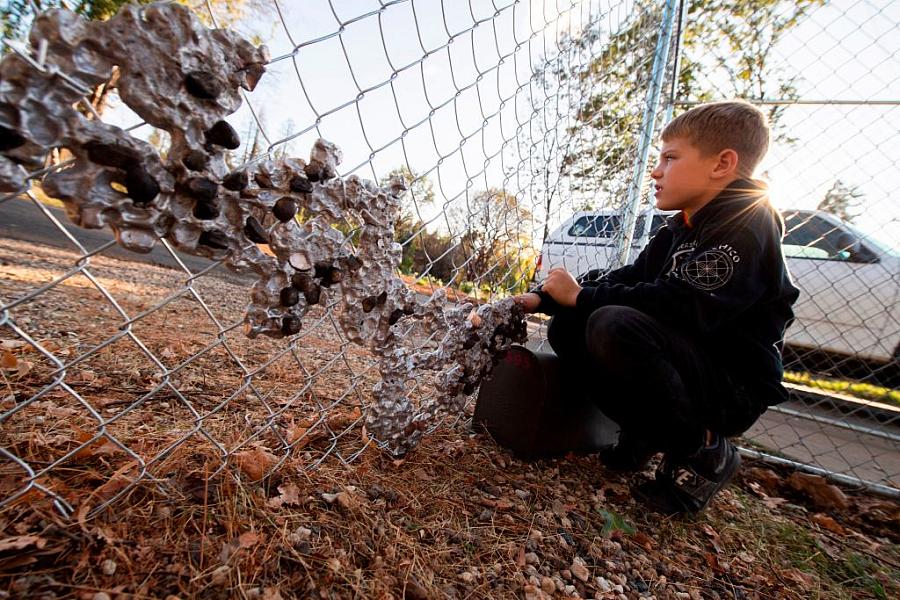How the aftermath of devastating wildfires takes a toll on children's health

Levi Lundy reflects beside recovered molten metal from his father's truck, which melted in the Camp Fire in Paradise, Calif.
(Photo by Robyn Beck/AFP/Getty Images)
I moved from Chico to Santa Rosa, California, less than a year after the Tubbs Fire destroyed over 5,000 homes in the city. Just a few months later the Camp Fire all but destroyed the town of Paradise, 12 miles away from the home I had just moved from. Living in both of these communities helped me understand that the devastation from these fires did not all happen in one night. How residents fared was determined by the safety net services available before the fires and the recovery resources offered after.
In both Paradise and Santa Rosa, kids were often the most vulnerable. In a series of stories for the 2019 California Fellowship, I sought to find out how children in both communities were faring in the aftermath of these wildfires and explored how we could improve their outcomes.
In Paradise, high rates of poverty in the area meant families were more vulnerable. According to the latest census data, nearly 14% of residents in the city were living below the federal poverty line. Butte County residents also reported higher rates of adverse childhood experiences than residents of any other county in the state. That was before the Camp Fire even happened. Research shows that the greater the number of adverse experiences one has during childhood, the more likely they are to experience health problems later in life. One Paradise school counselor I interviewed noted that kids who experienced trauma before the fire needed much longer to recover emotionally. The same went for kids whose families lacked the financial resources to find stable housing afterwards.
In Santa Rosa, agencies worked quickly to provide recovery resources, but some needs were overlooked. Many local agencies and nonprofits failed to translate recovery information into Spanish fast enough. Young people were often tasked with translating crucial information for their parents, increasing their already high levels of stress and responsibility. Youth who were not directly impacted by the fire still suffered from a ripple effect. This year, Sonoma County lost over $5 million dollars in property tax revenue and dramatically reduced health department funding to balance the budget. The health department’s Teen Parent Connections Program, which provides counseling and other services for teenage parents, lost all but two counseling positions due to these budget cuts. I published a story about a young woman who became pregnant at 14 and had relied on this program for services. The Sonoma County Board of Supervisors restored funding to this program about a month after the story aired.
When reporting on disasters, it is all too common for reporters to only focus on the days immediately following the incident. Following up with families and local institutions is crucial if we are to better understand the long-term health impacts on kids. As wildfire season becomes longer and more severe in California, we need to focus our reporting on protecting vulnerable populations. Here’s some advice for others reporting on trauma and health after natural disasters:
Allow more time for an interview than you think you’ll need. People who have been traumatized may need a lot of time to process what they’ve been through. It may take a while for them to get to the place you’re asking them to go. Try not to schedule interviews back to back or at times when you are on a tight deadline.
Take care of yourself. It’s easy to forget about your own health when talking with people who have been through so much. Their stories may affect you far more than you realize. I hadn't thought about my own mental health until an interviewee asked me what I was doing to take care of myself. Recognize when you are taking on too much and make time to decompress.
Understand what you’re asking of people. It takes a lot for people to talk about trauma. Don’t push people to talk about things they aren’t ready to talk about. Structure the interview so that the person you’re talking with has time to get comfortable with you first. Let them know they don’t have to talk about things they don’t want to. This is especially important when talking with kids.
Everyone has a story. Some of the most heartfelt stories I heard came from professionals in the field I had scheduled interviews with strictly to better understand the data. Don’t forget to ask people what they’ve been through, even if their personal story isn’t the explicit reason you scheduled the interview.
Be prepared to cut sources out of the story. You’ll certainly talk with people who you don’t have space to include in your final report. This can be especially difficult when someone opens up to you about a deeply personal experience. Be prepared to make the necessary cuts and realize that everyone you speak with helps inform your reporting. Be sure to communicate this with your sources so that they understand that their time and effort were still important to the story.
Listen to the community to better understand how to frame the story. In Santa Rosa and Paradise, people are proud of their resilience. It takes a strong person to make it through something so traumatic. I needed to characterize those I interviewed as survivors and not victims. In addition to reporting on vulnerability, I also highlighted their resilience and hope. I also found that people were more likely to engage with my reporting if they felt empowered to do something about the problem.

